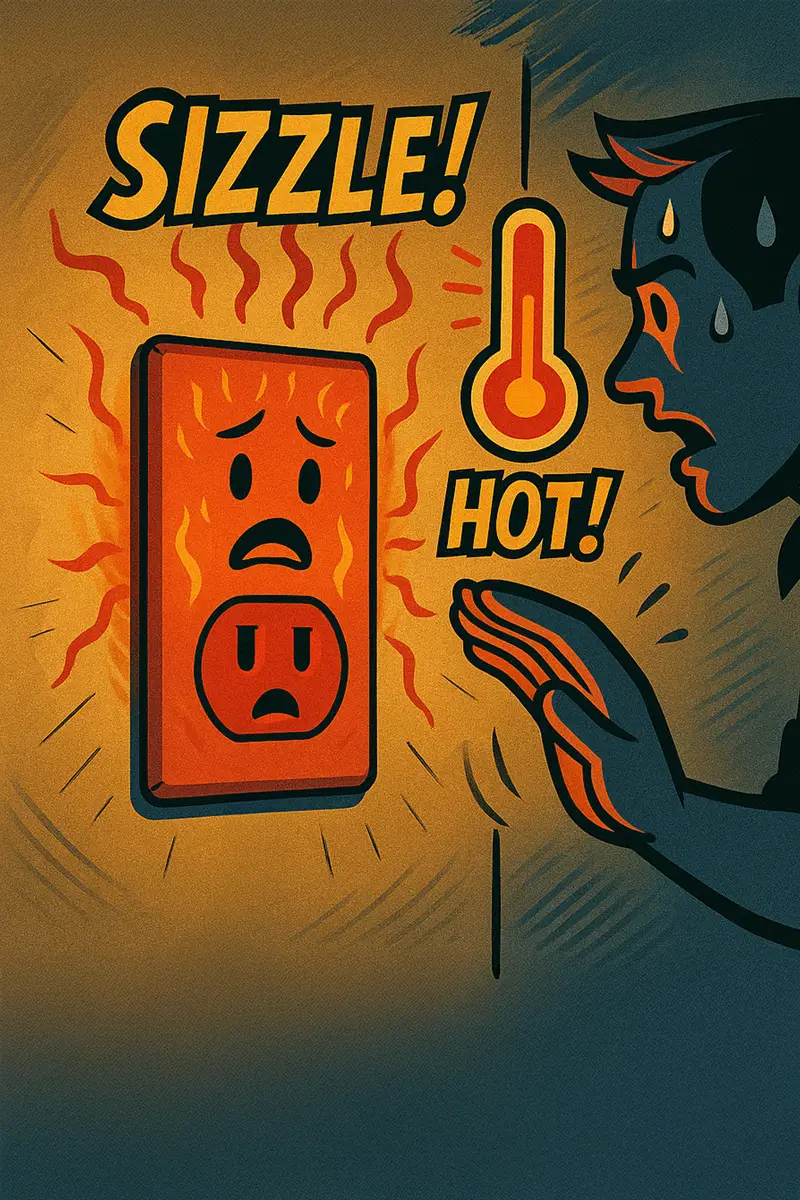
A hot outlet or switch is exactly what it sounds like – an electrical outlet or light switch that is noticeably warm or even hot to the touch during normal use. You might first detect this when unplugging a charger and feeling unexpected heat, or when flipping off a light switch and finding the toggle is warm. Slight warmth from a dimmer switch is normal (dimmers do run a little warm), but regular outlets and standard switches should stay cool. Discoloration (yellowing or browning) around the outlet or a faint burning smell are related warning signs that often accompany overheating.
Hot outlets and switches can appear in any home, but older homes in our area are prime territory for this issue. Why? Loose connections and aging components are a big factor. In many Northern Virginia homes built in the mid-20th century, the wiring may be solid copper that has expanded and contracted over countless seasons – screws loosen, connections get wobbly. A loose hot wire on an outlet creates resistance, which creates heat, turning the outlet into a tiny heater (not good!). Another cause is overloading – perhaps not enough to trip a breaker, but enough to make the outlet warm. Picture a home office in Maryland where a high-performance computer, printer, and space heater are all on the same outlet via a power strip; that heavy load over several hours can make the outlet warm up. We also see aluminum wiring (common in some 1960s-70s houses) as a culprit – aluminum connections run hotter, and if not properly addressed with special connectors, they can overheat outlets or switches. And then there’s dimmer switches: in DC’s historic homes, people love installing modern dimmers, but if you exceed the wattage rating (like putting 500W of bulbs on a 300W dimmer), the dimmer and the wall plate can get scorching hot. Combine any of these factors with the region’s high usage of HVAC and appliances, and you’ll find plenty of warm-to-hot outlets in need of a check-up.
A warm outlet isn’t just an odd quirk – it’s a screaming red flag in terms of safety. The heat is evidence that electrical energy is not flowing as it should; instead, it’s being lost as heat due to resistance. This can damage the outlet over time, melt the insulation, or even start to melt the plastic face of the outlet/switch (hence the discoloration you might see). Worst-case scenario, a hot outlet or switch can be the start of an electrical fire. In fact, many electrical fires begin at points of connection – like an outlet – where a loose wire arcs or a connection overheats and eventually ignites surrounding material. Another risk: if an outlet is hot and you plug something in, you might get a shock if the outlet is failing internally. It’s also possible for the device plugged in to get damaged from the abnormal heat and electrical behavior. In short, consistently hot outlets or switches are never normal and should raise immediate concern.
This issue is one where you don’t want to wait. If you discover an outlet or switch is hot (not just mildly warm from a dimmer under load, but truly hot), unplug any devices, turn off the circuit, and call an electrician. There’s no “home remedy” for a hot outlet other than reducing load (unplugging things) – and that only helps if overload was the sole cause. A licensed electrician will do a few critical things: check the tightness of all connections on that outlet/switch, inspect the wiring for any signs of burning or damage, and determine if the circuit itself is overloaded. Often, the fix might be as simple as replacing the outlet and properly securing the wires. In other cases, especially with older wiring, the electrician may need to shorten and re-strip wire ends or use special connectors if aluminum wiring is present (since aluminum-caused heating must be handled properly). They’ll also look at the broader picture – is this outlet on a circuit that’s at max capacity? If yes, they might recommend adding a new circuit or redistributing some appliances to prevent recurrence. If a dimmer switch is hot, the electrician will verify it’s rated for the wattage of the lights it controls (or possibly that it’s the correct type of dimmer for LED lights, etc., as mismatches can cause heat). Safety tip: Don’t ignore the problem or assume it’s always “just working hard” – an experienced electrician’s assessment can prevent a potential disaster.
Your sense of touch can be a superhero in disguise – detecting hot spots that signal danger. As Dr. Electric likes to say, “warm outlets = warning outlets.” It’s not an enemy to battle alone. Our pros will swoop in, pinpoint the hot spot’s cause with precision, and cool things down. After all, outlets should handle plugs, not double as hand warmers! Stay vigilant, and you’ll stop the fire before it starts.
Dr. Electric offers a range of services to enhance safety, reliability, and performance. Get in touch or check out our List of Common Electrical Requests.
You can also text our support team at 833-337-3532 or email: info@drelectric.com